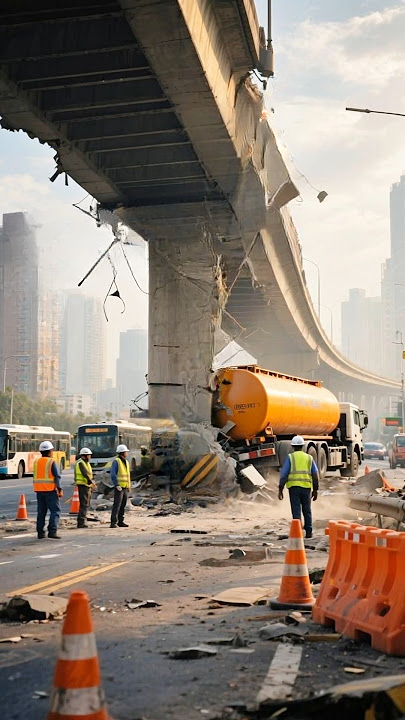Introduction: When a Few Seconds Captivate the World
In an age where short videos dominate attention spans and trends shift within minutes, it is rare for a clip to hold global focus for more than a fleeting moment. Yet recently, a brief video managed to do exactly that. Shared first on TikTok before spreading to every major platform, the clip showed an ordinary fuel tanker parked beneath a visibly deteriorating bridge. At first glance, it seemed mundane, but within seconds the unsettling details became clear: cracks in the structure, concrete sagging dangerously, and steel reinforcement straining under pressure.
Viewers around the world immediately sensed that something was terribly wrong. Was this a case of infrastructure seconds away from collapse? A staged awareness campaign designed to highlight the importance of maintenance? Or perhaps an example of digital trickery so convincing that it blurred the lines between reality and illusion?
Whatever the origin, the video ignited conversations far beyond entertainment. It tapped into a universal anxiety: the reliability of the structures we depend upon every day.

Why This Video Struck a Nerve
Unlike most viral clips that vanish from memory as quickly as they appear, this video lingered. People shared it not only because of its suspense but because of the deep, relatable fear it evoked.
Bridges, highways, and overpasses are part of daily life. They are not abstract engineering projects but living elements of society, carrying millions of people and goods every day. The possibility that such a structure could fail without warning is not just dramatic—it is profoundly personal.
Psychologists often describe humanity’s fascination with what they call “edge-of-disaster moments.” These are scenarios where danger appears imminent but not yet realized, creating a mix of suspense, fear, and fascination. Watching such moments unfold—especially from the safety of a screen—gives people a way to experience fear vicariously.
This explains why audiences could not look away from the tanker video. The stillness of the scene beneath an unstable bridge felt like a ticking clock. Even without knowing the outcome, people were captivated by the possibility of what might happen next.
The Ambiguity That Fueled Speculation
The video’s greatest power may have been its lack of context. There were no captions, no official reports, and no location details provided. This absence of information created fertile ground for speculation.
Some viewers believed it was genuine, filmed moments before a real collapse.
Others suggested it was staged during controlled demolition or repair work to highlight the risks of neglect.
A third group insisted the clip was digitally edited, pointing to the sophistication of modern software that can seamlessly blend fact and fiction.
Without confirmation, the truth remained elusive. Yet paradoxically, the uncertainty only increased its reach. People debated its authenticity, shared their theories, and drew comparisons to real-world tragedies.
Real-Life Parallels: When Bridges Do Fail
Part of the video’s impact came from the fact that bridge collapses are not unheard of. While rare, they have occurred in different parts of the world, often with devastating consequences.

Taiwan, 2019 – The sudden collapse of the Nanfang’ao Bridge shocked the nation, sending vehicles and fishing boats into the water below.
Brazil, 2024 – A highway bridge gave way while a tanker attempted to cross, causing structural damage and raising environmental concerns due to spillage.
India, 2025 – The Gambhira Bridge in Gujarat failed during morning traffic, leaving vehicles stranded and prompting long rescue operations.
Each of these incidents highlighted not only the fragility of infrastructure but also the far-reaching consequences—economic disruption, environmental challenges, and above all, loss of human life.
When viewers saw the viral clip, even without confirmation of its authenticity, these memories surfaced. The video acted as a mirror reflecting real events, blurring the boundary between possibility and precedent.
A Broader Issue: Global Infrastructure Under Strain
Beyond its entertainment value, the viral video symbolized a growing international concern: the aging state of infrastructure.
Many bridges currently in use were built decades ago, designed for lighter traffic and smaller vehicles than today’s reality. Now, they face pressures far beyond what their creators envisioned.
Key challenges include:
Overcapacity: Modern freight trucks and tankers weigh significantly more than vehicles of the past.
Maintenance delays: Budget restrictions often push repairs down the priority list, allowing small problems to grow into structural risks.
Climate pressures: Extreme weather events, from heavy rainfall to heatwaves, accelerate wear and tear on construction materials.
Urban expansion: Rapidly growing cities place additional strain on existing infrastructure without equivalent investment in new projects.
Engineering associations have repeatedly warned that thousands of bridges worldwide are rated as “structurally deficient” or “functionally obsolete.” The viral video, whether authentic or not, acted as a stark visual representation of these warnings.
Emotional Reactions: Fear, Trust, and Resilience
What sets infrastructure failures apart from other dangers is that they challenge our sense of trust in everyday life. Most people cross bridges without a second thought. Safety is assumed. When images suggest otherwise, that trust fractures.
But alongside fear, such crises also highlight human resilience. Past tragedies have revealed acts of courage and solidarity:
Drivers risking their own safety to avoid endangering others.
First responders working tirelessly in hazardous conditions.
Communities uniting to provide support in the aftermath.
The viral tanker video reminded viewers of both extremes: the vulnerability of human structures and the strength of human spirit.
The Role of Social Media in Shaping Perception
In earlier decades, news of structural failures would have taken days to reach global audiences. Today, a short video can circle the globe within minutes. This speed brings both benefits and challenges.
Positive effects: Public awareness of safety issues rises, encouraging governments to prioritize maintenance and inspections.
Negative effects: Lack of verified information can lead to confusion, with speculation spreading as quickly as facts.
The viral tanker video illustrated this perfectly. Even without confirmation, it pushed conversations about infrastructure into mainstream dialogue. People began questioning not just the authenticity of the clip but also the reliability of the bridges they use daily.
Lessons for Policymakers and Communities
Whether the video was real, staged, or digitally created, the lessons it raised remain valuable.
Proactive Maintenance: Regular inspections and timely repairs are far less costly than responding to disasters.
Transparency: Governments should communicate openly about infrastructure conditions to build public trust.
Preparedness: Emergency training for responders can significantly reduce harm when failures do occur.
Public Education: Viral content, even if dramatized, can be used to promote awareness of safety and responsibility.
By treating the clip not only as entertainment but as a wake-up call, policymakers have an opportunity to strengthen resilience and protect lives.
Final Reflection: Seconds That Last Forever
Ultimately, the viral tanker video was more than a fleeting trend. It became a symbol of society’s fragile trust in the systems that connect us. Bridges are not just physical structures—they represent connection, commerce, and progress. When they appear unstable, that trust is shaken.
The true power of the clip lies not in whether it depicts reality but in the conversations it has inspired. It challenges individuals, communities, and governments alike to reflect on infrastructure, safety, and vigilance.
We may never know the full story behind the video, but its message endures: safety is not automatic. It must be earned, protected, and maintained through responsibility and foresight.
The image of that tanker beneath the weakening bridge will remain etched in memory—a reminder that ordinary routines rely on extraordinary trust, and that vigilance is the key to ensuring we are never caught unprepared in those irreversible “moments from disaster.”



